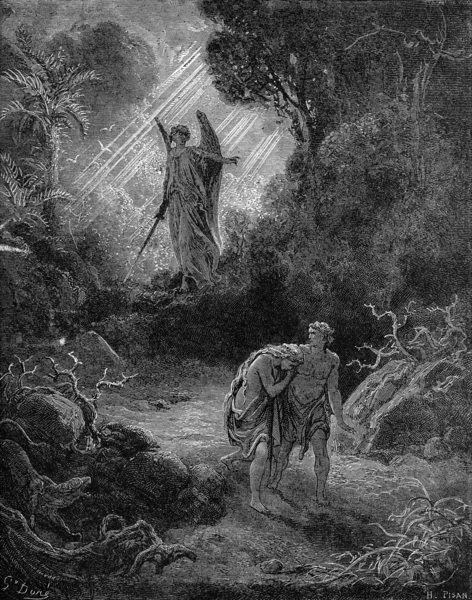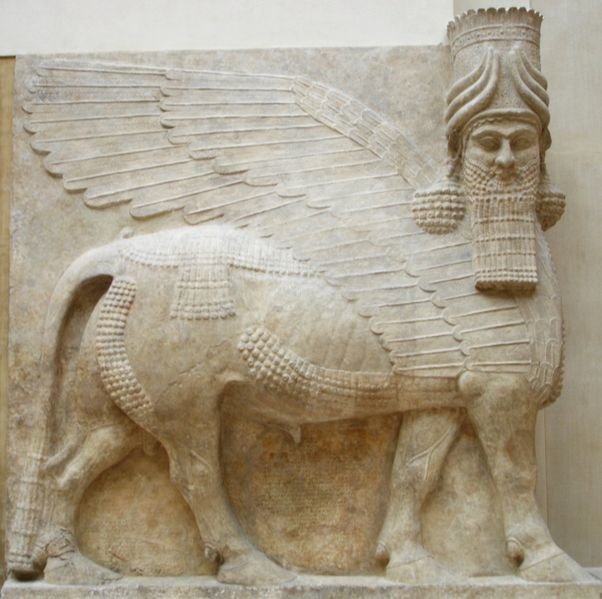Guarding the Gate of Eden
“Therefore the LORD God expelled the man from the Garden of Eden so he would work the ground from which he had been taken. After he had expelled the man, the LORD God placed winged angels at the eastern end of the Garden of Eden, along with a fiery whirling sword, to prevent access to the tree of life.” –Genesis 3: 23-24
Adam and Eve find themselves in a bind. Their God, their protector, their benefactor, not only has expelled them from their home in paradise; He also has forbidden them to ever step foot on that hallowed ground again. And to extenuate the point, God placed Cherubim at the gate of Eden to make sure the two (and by extension, mankind as a whole) would not find entrance again.
The Cherubim are fascinating creatures. God later instructed Moses to place images of them atop the Ark of the Covenant, on either side of the mercy seat. The imagery here is obvious: as soon as Adam and Eve committed the sin of disobedience and introduced sin into the world, God immediately established a new form of worship. Man would no longer be allowed direct contact with The Almighty as he had enjoyed in Paradise. For now only the angels would congregate around God’s throne and bask in the glory of His presence. Where God manifests himself in a stated place, the angels would appear. As for man, it would take direct intervention by Jesus Christ before we could ever experience the Glory of God again.
The Cherubim perform a specific task at the gate of Eden: By the flaming sword turning every way, or flame folding back on itself, we realize the formidable appearance these cherubim assumed. They assumed this fierce countenance in order to render the passage to the tree of life inaccessible. It is evident from the context of various Biblical passages in which the word “angel” appears that the word does not always represent the same idea. In this case it would seem that the angels represent superhuman beings whose duty it was to stand guard until God otherwise relieves them. This concept of “angels as guards” is similar to the jenei of the Arabs (from where we get our word genie).
The Old Testament does not show any evidence that the Jews considered the Cherubim as intercessors between God and mankind but were closely linked in God’s glory. Manlike in appearance and double winged, they symbolized God’s power and mobility. In the New Testament, they it might be read that they will act as holy attendants in the Apocalypse. Catholic tradition describes them as angels who have an intimate knowledge of God and continually praise Him.
In their function as guardians of Paradise, the cherubim remind us of the winged bulls and lions of Babylonia and Assyria, colossal figures with human faces standing guard at the entrance of temples and palaces, just as in Egypt sphinxes guarded approaches to the sanctuaries.
Some scholars do not believe the cherubim are actually guarding the entrance to Eden. They believe the passage in Genesis indicates that God placed Himself at the Gate of Eden. His glorious majesty, or Shechinah, dwells there between the Cherubim. This idea is reflected in the construction of the Ark of the Covenant (specifically the Mercy Seat). In other words, Eden represents the home of God, who resides at the Eastern Gate between the cherubim.
In the Tabernacle, two cherubim of solid gold rested on the golden slab of the “lid,” or “mercy-seat,” facing each other, with wings outstretched above, so as to constitute a throne on which the glory of the Lord appeared, and from which He spoke. There were also cherubim woven into the texture of the inner curtain of the Tabernacle and the veil.





please describe what the last picture is portraying??